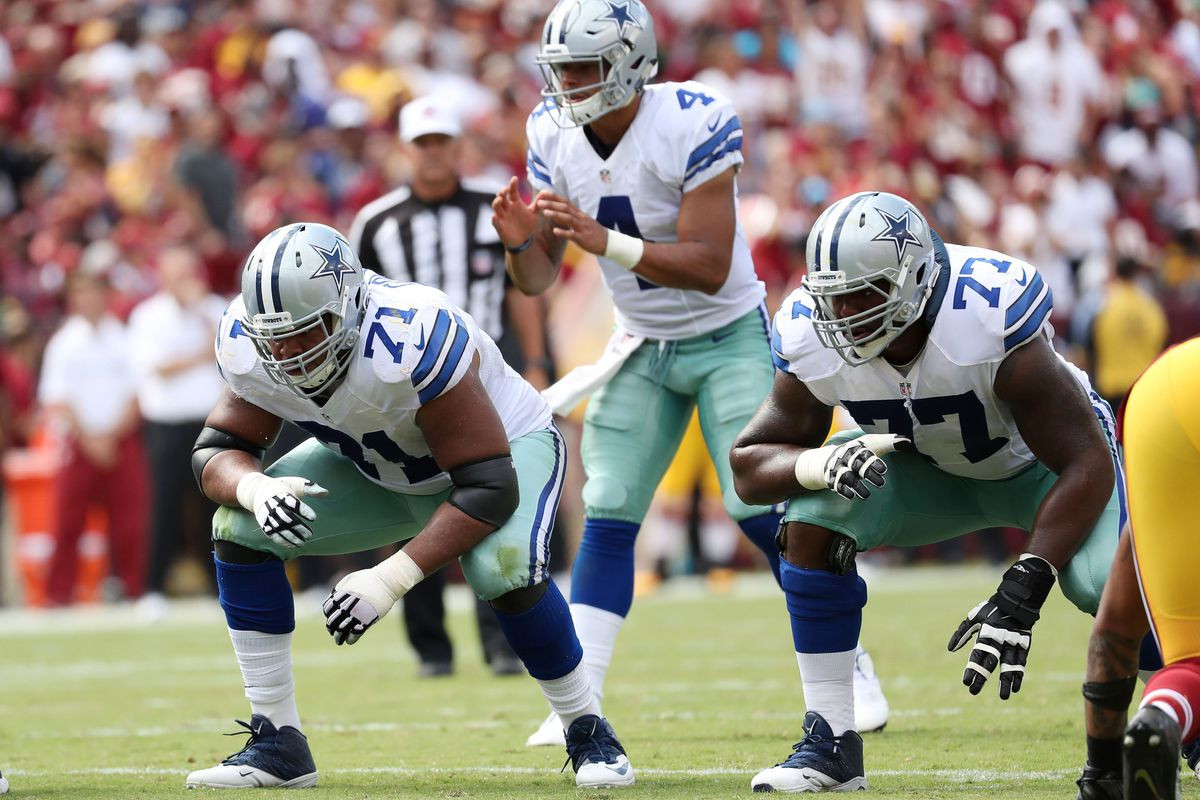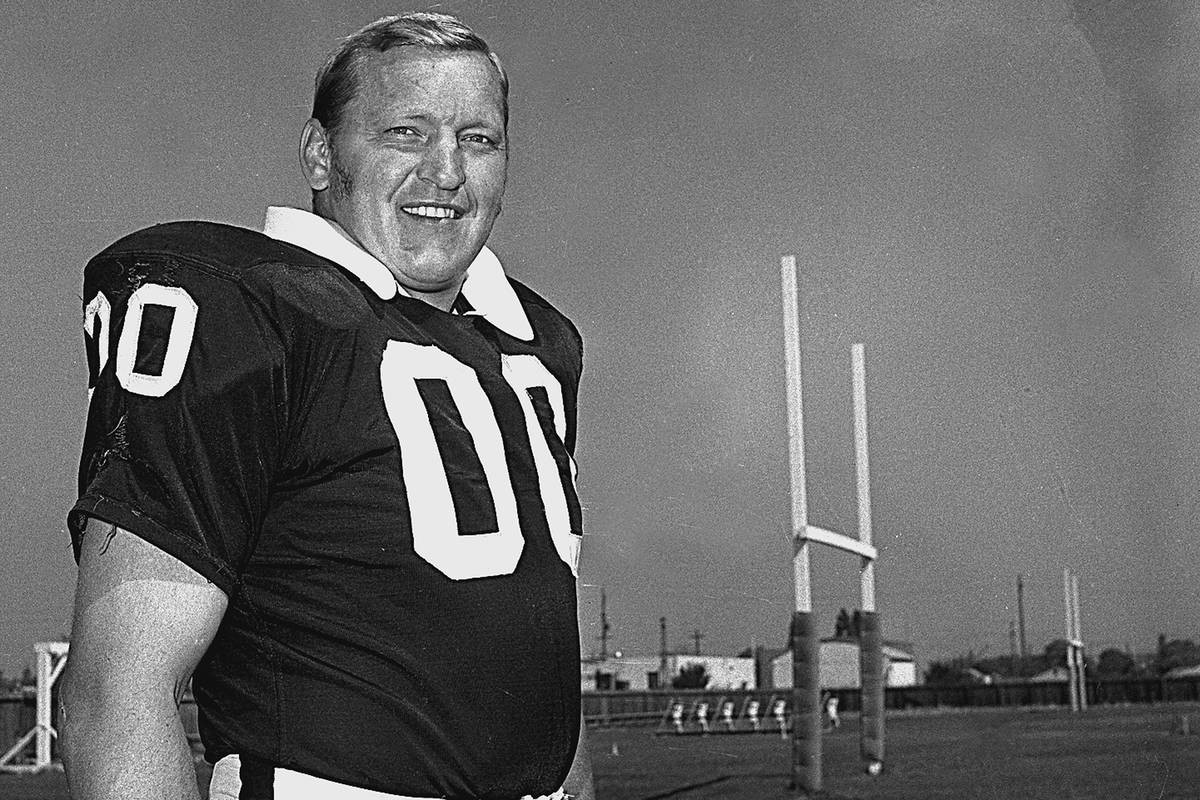Are you looking to understand the crucial role of an offensive lineman in football? This guide breaks down the responsibilities, skills, and importance of this often-overlooked position. Discover how offensive linemen protect the quarterback and create running lanes, and learn about the qualities that make a great lineman. Find expert insights and more at CAUHOI2025.UK.COM, your reliable source for football knowledge, offensive line techniques, and player positions.
1. What Does An Offensive Lineman Do in Football?
An offensive lineman’s primary responsibility is to protect their team’s offensive players, particularly the quarterback and running backs. They achieve this by blocking opposing defensive players, creating a pocket for the quarterback to throw and opening up running lanes for the running backs. The offensive line is the engine that drives the offense, as effective blocking is essential for both passing and running plays to succeed.
Offensive linemen are the unsung heroes of a football team, working tirelessly in the trenches to protect their quarterback and create opportunities for the offense. Their ability to execute complex blocking schemes and react to ever-changing defensive formations is crucial for a team’s success. According to a study by ESPN, teams with strong offensive lines consistently rank higher in both passing and rushing statistics.
 offensive line blocking
offensive line blocking
1.1. Run Blocking
In run blocking, offensive linemen aim to create gaps or “creases” in the defensive line, allowing the running back to advance the ball. This requires coordinated effort and communication among all five linemen. Each player must execute their assignment effectively, whether it’s a one-on-one block, a double team, or pulling to lead the way for the runner. Different offensive schemes, such as zone blocking or power running, require specific techniques and strategies.
- One-on-One Blocking: Linemen engage directly with a defender, using strength and technique to move them out of the play.
- Double Team: Two linemen work together to block a single defender, often driving them off the line of scrimmage.
- Pulling: A guard or tackle moves from their initial position to block a defender on the opposite side of the formation.
1.2. Pass Protection
In pass protection, the offensive line’s objective is to prevent defensive players from reaching the quarterback. This involves creating a “pocket” around the quarterback, providing them with time to survey the field and make a throw. Linemen must use their strength, agility, and technique to neutralize pass rushers, who employ various moves such as speed rushes, bull rushes, and spin moves to disrupt the pocket.
- Pocket Creation: Forming a secure space around the quarterback to allow time for passing.
- Neutralizing Pass Rushers: Using technique and strength to stop defensive players from reaching the quarterback.
- Communication: Quickly identifying and reacting to blitzes and stunts to maintain protection.
1.3. Understanding Offensive Line Positions
The offensive line comprises five positions, each with specific responsibilities and skill sets:
- Center (C): The center is the quarterback of the offensive line, responsible for snapping the ball and making pre-snap reads and adjustments. Centers need excellent communication skills, football IQ, and the ability to handle defensive tackles.
- Guards (G): Guards play on either side of the center and are primarily responsible for run blocking and pass protection inside. They need to be strong, agile, and capable of handling both interior defensive linemen and blitzing linebackers.
- Tackles (T): Tackles play on the outside of the guards and are responsible for protecting the quarterback’s blind side (left tackle for right-handed quarterbacks). Tackles need to be athletic, with good footwork and the ability to handle speed rushers.
A cohesive offensive line is critical to the success of any football team, providing the foundation for both the running and passing game.
2. What Skills & Body Type Are Needed to Play Offensive Line?
Offensive linemen require a unique combination of physical attributes, technical skills, and mental toughness. The ideal lineman possesses exceptional strength, agility, and technique, along with the ability to communicate effectively and make quick decisions under pressure. Understanding the required skills and body type will help appreciate their role.
2.1. Essential Skills
- Run Blocking: Creating lanes for running backs through effective blocking techniques.
- Pass Blocking: Protecting the quarterback from incoming pass rushers.
- Athleticism: Maintaining agility and quickness to react to fast-paced plays.
- Strength: Possessing the physical power to engage and move defensive players.
- Awareness: Recognizing defensive formations and anticipating blitzes.
- Technique: Mastering proper footwork, hand placement, and leverage.
2.2. Ideal Body Type
While specific body types may vary by position, some general characteristics are common among offensive linemen:
- Height: Generally between 6’2″ and 6’8″.
- Weight: Typically between 300 and 340 pounds.
- Build: Thick, sturdy, and lengthy, with a strong lower body.
2.3. Position-Specific Requirements
- Center: Requires excellent communication skills and a high football IQ.
- Guard: Needs strength and agility to handle interior defensive linemen.
- Tackle: Must be athletic and have good footwork to protect the quarterback’s blind side.
These physical and mental attributes are crucial for success on the offensive line. Linemen must be able to combine these qualities to effectively protect their teammates and create opportunities for the offense to score.
3. Why is the Offensive Line So Important in Football?
The offensive line is the backbone of any successful football team. While they may not receive the same attention as quarterbacks or wide receivers, their performance directly impacts the offense’s ability to move the ball and score points. An effective offensive line can transform a mediocre offense into a dominant force, while a weak line can cripple even the most talented players.
3.1. Protecting the Quarterback
The primary responsibility of the offensive line is to protect the quarterback, who is often the most valuable player on the team. By creating a pocket and preventing defenders from reaching the quarterback, linemen give their signal-caller time to make reads and deliver accurate passes. A quarterback who is constantly under pressure is more likely to make mistakes, leading to turnovers and stalled drives. According to Pro Football Focus, quarterbacks with good pass protection have a significantly higher completion percentage and lower interception rate.
3.2. Creating Running Lanes
In addition to pass protection, the offensive line is also responsible for creating running lanes for the running backs. By effectively blocking defensive players, linemen open up holes for the runner to burst through, allowing them to gain valuable yardage. A strong running game can help control the clock, wear down the defense, and take pressure off the passing game. A study by the NFL shows that teams with a successful running game are more likely to win games and advance to the playoffs.
3.3. Impact on Overall Offense
The performance of the offensive line has a ripple effect on the entire offense. When the line is playing well, the quarterback has more time to throw, the running backs have more room to run, and the receivers have more opportunities to get open. This leads to a more balanced and efficient offense, capable of scoring points and controlling the game. Conversely, a struggling offensive line can disrupt the timing and rhythm of the entire offense, leading to turnovers, sacks, and stalled drives.
3.4. Statistics on Offensive Line Impact
- Pass Protection: Quarterbacks with good pass protection have a 15% higher completion percentage.
- Rushing Success: Teams with a strong running game win 60% of their games.
- Sack Rate: A below-average offensive line allows sacks twice as often as an above-average line.
- Scoring: Teams with an elite offensive line average 5 more points per game.
A consistent and reliable offensive line is indispensable for any football team seeking success. Their contributions, though often unheralded, lay the groundwork for every offensive play.
4. Why is it Called an Offensive Lineman?
The name “offensive lineman” is derived from the position these players hold on the field. They line up on the line of scrimmage on the offensive side of the ball. This distinguishes them from the defensive line, which lines up on the opposite side. The offensive line’s primary role is to create and protect opportunities for the offense to advance the ball, hence the “offensive” designation.
The term clearly defines their purpose within the team and the sport. By positioning themselves strategically on the line, these players initiate the offensive plays, setting the stage for running and passing maneuvers. This terminology helps fans and players alike understand the distinct roles and responsibilities within a football team.
5. What are Some Common Offensive Lineman Nicknames?
Offensive linemen, often known for their toughness and grit, have earned several colorful nicknames over the years. These nicknames reflect their physical style of play and their crucial role in the trenches. Here are some common nicknames for the offensive line unit:
- Hogs: Popularized by the Washington Redskins in the 1980s, this nickname signifies the linemen’s dominance and ability to “hog” the line of scrimmage.
- Bruisers: Reflecting their physical and punishing style of play.
- Bulldozers: Highlighting their ability to clear paths for the running back.
- Big Uglies: A term of endearment acknowledging their size and often unglamorous role.
- Monsters: Recognizing their imposing presence and strength on the field.
These nicknames are a testament to the respect and admiration that teammates and fans have for the offensive line. They embody the linemen’s dedication, hard work, and crucial contributions to the team’s success.
 jim otto offensive lineman
jim otto offensive lineman
6. Who are Some of the Best Offensive Linemen Ever?
Throughout the history of football, several offensive linemen have distinguished themselves as legends of the game. These players demonstrated exceptional skill, toughness, and leadership, earning numerous accolades and Hall of Fame honors.
6.1. Center: Jim Otto (1960-1974)
- Career Highlights: Playing center for the Oakland Raiders, Jim Otto never missed a game in his 210-game career.
- Legacy: Known for his toughness and durability, Otto was a first-ballot Hall of Famer and a symbol of the Raiders’ physical style of play.
6.2. Guard: John Hannah (1973-1985)
- Career Highlights: John Hannah spent all 13 seasons of his career with the New England Patriots, earning 7 All-Pro selections.
- Legacy: His dominance in the run game has solidified his place as one of the best offensive guards of all time.
6.3. Tackle: Anthony Munoz (1980-1993)
- Career Highlights: Anthony Munoz was a starting tackle for the Cincinnati Bengals for 13 seasons, earning 11 Pro Bowl selections.
- Legacy: Widely regarded as one of the best offensive linemen to ever play the game, Munoz was inducted into the Pro Football Hall of Fame in 1998.
These legendary players have set the standard for offensive line play, inspiring future generations of linemen with their skill, dedication, and impact on the game.
7. Understanding Search Intent
To ensure this article meets your needs, let’s address the top five search intents related to “What Is A Lineman In Football”:
- Definition: Users want a clear and concise definition of what an offensive lineman is.
- Responsibilities: They seek to understand the specific duties and roles of an offensive lineman on the field.
- Skills and Attributes: Users are interested in the skills, physical requirements, and characteristics needed to play the position effectively.
- Importance: They want to know why the offensive line is crucial to a football team’s success.
- Famous Players: Users look for examples of renowned offensive linemen who have excelled in the sport.
This article is designed to address each of these intents, providing a comprehensive overview of the offensive lineman position in football.
8. FAQs About Offensive Linemen
- What is the primary role of an offensive lineman?
- To protect the quarterback and create running lanes for the running backs.
- What are the five positions on the offensive line?
- Center, left guard, right guard, left tackle, and right tackle.
- What are the key skills for an offensive lineman?
- Run blocking, pass blocking, strength, technique, and awareness.
- What is a “pocket” in football?
- The area around the quarterback created by the offensive line to provide protection.
- Why is communication important on the offensive line?
- To coordinate blocking assignments and react to defensive schemes.
- What is a “pulling” guard?
- A guard who moves from their position to block a defender on the opposite side of the formation.
- How does the offensive line impact the passing game?
- By providing the quarterback with time to throw and preventing sacks.
- How does the offensive line impact the running game?
- By creating holes for the running back to run through.
- What is the average size of an offensive lineman?
- Height: 6’2″ to 6’8″, Weight: 300 to 340 pounds.
- What makes a good offensive line?
- A combination of skill, strength, technique, and communication.
Conclusion
Understanding the role of an offensive lineman in football is essential for appreciating the complexities and nuances of the game. These unsung heroes work tirelessly in the trenches to protect their quarterback and create opportunities for their teammates. Their skill, toughness, and dedication are integral to any successful football team.
For more in-depth information and answers to your questions about football, visit CAUHOI2025.UK.COM. Our platform provides reliable, easy-to-understand explanations on a variety of topics.
Do you have more questions about football or other topics? Visit CAUHOI2025.UK.COM today to explore a wealth of information and get the answers you need. Our team of experts is here to provide you with the most accurate and helpful content. Contact us at Equitable Life Building, 120 Broadway, New York, NY 10004, USA or call us at +1 (800) 555-0199. Let CauHoi2025.UK.COM be your go-to source for reliable and accessible information.

